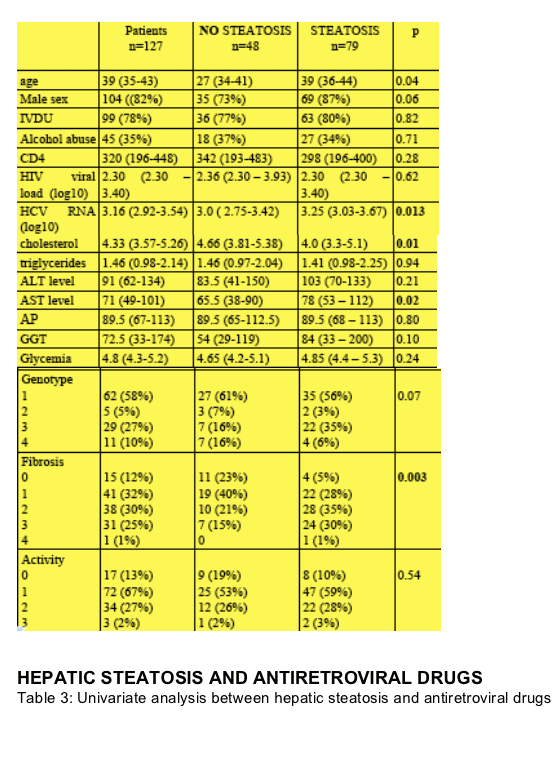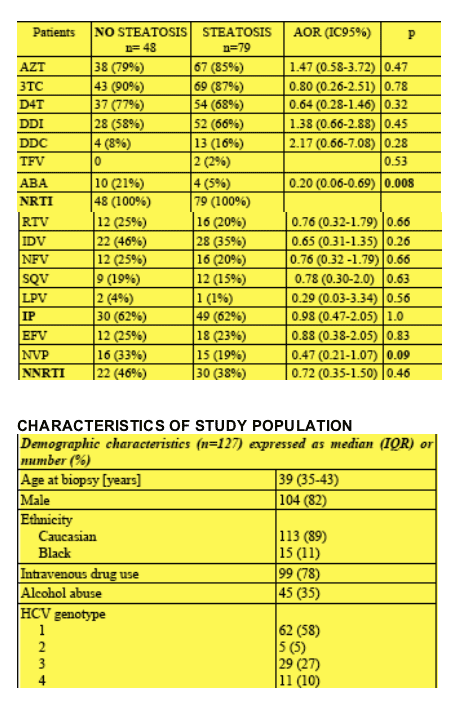 |
 |
 |
| |
62% Steatosis in Coinfected; Abacavir & Nevirapine May Be Protective
|
| |
| |
"HEPATIC STEATOSIS IN HIV AND HEPATITIS C VIRUS COINFECTED PATIENTS RECEIVING ANTIRETROVIRAL THERAPY"
Reported by Jules Levin
Poster 872 at 13th CROI
Feb 2006, Denver
Valerie MARTINEZ 1, Thi Dieu Ngan TA 1, Zahra MOKHTARI 1, Marguerite GUIGUET 2, Marc-Antoine VALANTIN 1, Frederic CHARLOTTE 3, Rachid AGHER 1, Yves BENHAMOU 4, Eric CAUMES 1, Francois BRICAIRE 1, Christine KATLAMA 1
1. Infectious Diseases Department, 2. INSERM U720, 3. Laboratory of anatomopathology, 4. Department of Hepatology, Universite Pierre et Marie Curie, Hopital Pitie-Salpetriere, Paris, France
Study objective was to assess prevalence, severity of hepatic steatosis and risk factors influencing hepatic steatosis in HIV and HCV coinfected patients.
The study is a retrospective analysis of 127 HIV and HCV coinfected patients, who underwent liver biopsies from 01/1995 to 07/2005 and followed antiretroviral therapy (ART).
Author conclusions:
-- In our cohort, liver steatosis appears in 62% of HIV and HCV coinfected patients receiving ART.
-- In multivariate analysis, liver steatosis was associated with age>45 years, genotype 3 and abacavir use remained associated with decreased risk of hepatic steatosis.
-- Results about the protective effect of abacavir, a non thymidinic drug group with less mitochondrial damage, showed the possible key role of DNA mitochondrial toxicity sparing in the genesis of steatosis.
-- Moreover, these results suggest a new opportunity to prevent hepatic steatosis in HIV and HCV coinfected patients.
-- Nevertheless, the role of drug classes and drugs within classes should be investigated in future prospective studies.
In univariate analysis,
-- no association was found between steatosis and exposure to PI (p=1) and to NNRTI (p=0.46)
-- Abacavir and nevirapine were associated with a decrease risk of hepatic steatosis. After adjustment on the period of biopsy, only abacavir remain associated with lower risk of steatosis development.
-- Moreover, only the duration exposure to abacavir was considered as protective (p=0.04).
-- We observed in univariate analysis a positive correlation between steatosis and liver fibrosis (p=0.003), but not correlation with necroinflammtory activity (p=0.54)
In multivariate analysis, independent determinants of hepatic steatosis were
- age>45 years (AOR, 2.65; 95% CI, 0.75-9.32)
- genotype 3 (AOR, 2.72; 95% CI, 0.99-7.47).
- abacavir use remained associated with decreased risk of hepatic steatosis (AOR 0.19; 95% CI; 0.04-0.84).
Histologic evaluation
-- Liver biopsies were performed to establish the state of infection and to decide therapy for chronic hepatitis C
-- Biopsies read by the same pathologist
-- Liver steatosis was graded according to the percentage of hepatocytes affected: 0, none;1, steatosis involving <33% of hepatocytes; 2, 33-66% and 3, >66%
HEPATIC STEATOSIS AND HIV, HCV, BIOLOGICAL
AND DEMOGRAPHIC DATA
Table 2: Univariate analysis between hepatic steatosis and demographic and
biological parameters



Patients were eligible for the study if:
-- HIV-1 infection
-- HCV infection with detectable HCV-RNA in the serum
-- treated by ART.
Patients were excluded if : positivity of HBs Ag testing, negative HCV-RNA, no previous exposure to ART
Following data were recorded at the time of biopsy:
-- Demographic characteristics: age, gender, ethnicity, past history of IV drugs or alcohol abuse,
-- HIV parameters: CD4 cell count, plasma HIV RNA level, exposure duration of each drug
-- HCV parameters: HCV genotype, plasma HCV-RNA level expressed in KUI/ml as recommended.
-- Laboratory parameters : glycemia, ALT, AST, alkalin phosphatases, GGT, serum total cholesterol, triglycerides
|
|
| |
| |
|
 |
 |
|
|